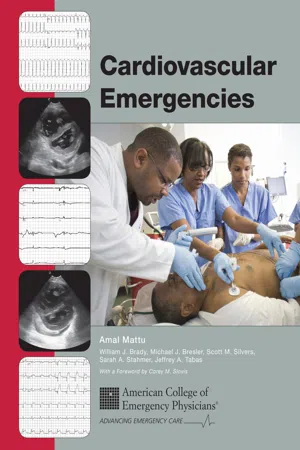
- English
- ePUB (mobile friendly)
- Available on iOS & Android
Cardiovascular Emergencies
About this book
Acute chest pain. Acute heart failure. Cardiac arrest. Tachycardia. Syncope.
If you take care of patients in an emergency department or some other "on-demand" facility, you have to be ready to identify and correctly treat cardiovascular emergencies any time – every time – they present.
So ARE you ready?
Learn now from the very best cardiovascular emergency medicine experts in the United States. Every one of the 21 chapters focuses on initial approach and evidence-based treatment -- all the info you need right away.
Read this book and you WILL save lives.
Published by the world's largest emergency medicine organization, the American College of Emergency Physicians, Cardiovascular Emergencies facilitates the efficient and cutting-edge delivery of care to patients who present with acute cardiovascular conditions. With more than 6 million people presented to U.S. emergency departments every year with chest pain, emergency physicians have the difficult task of differentiating life-threatening causes from more benign ones. And beyond chest pain, emergency physicians care for patients with other forms of cardiac disease—arrhythmias, infections, cardiovascular complications from other conditions, and they must be able to identify these conditions, assess their severity, and provide immediate, often lifesaving, interventions in the less-than-ideal conditions of a busy ED. This book teaches you the essentials of diagnosing and managing cardiovascular disorders from the experts.
Each of the 21 chapters focuses on an issue of critical importance in the care of patients with cardiovascular emergencies—emergencies that can present in any ED on any day in any community. The book includes hundreds of images, figures, and tables, and key points that you will use every time you treat a patient, brings together highly respected emergency physician educators to teach the essentials of diagnosing and managing cardiovascular disorders.
Key Elements:
- Approach to Acute Chest Pain
- The ECG in the Evaluation and Management of ACS
- Biomarkers and Imaging
- Bedside Ultrasound for Emergency Cardiovascular Disorders
- Modern Treatment of STEMI and NSTEMI
- Cardiogenic Shock
- Acute Heart Failure
- Bradyarrhythmias
- Narrow Complex Tachycardia
- Wide Complex Tachycardia
- Syncope
- Modern Management of Cardiac Arrest
- Post-Cardiac Arrest Syndrome
- Pericarditis, Myocarditis, and Endocarditis
- Hypertensive Emergencies and Elevated Blood Pressure
- Cardiac Disease in Special Populations: HIV, Pregnancy, and Cancer
- Special Populations: Pulmonary Hypertension and Cardiac Transplant
- Pharmacologic Approach to Emergency Cardia Patient
- Complications of I
Frequently asked questions
- Essential is ideal for learners and professionals who enjoy exploring a wide range of subjects. Access the Essential Library with 800,000+ trusted titles and best-sellers across business, personal growth, and the humanities. Includes unlimited reading time and Standard Read Aloud voice.
- Complete: Perfect for advanced learners and researchers needing full, unrestricted access. Unlock 1.4M+ books across hundreds of subjects, including academic and specialized titles. The Complete Plan also includes advanced features like Premium Read Aloud and Research Assistant.
Please note we cannot support devices running on iOS 13 and Android 7 or earlier. Learn more about using the app.
Information
CHAPTER 1
Approach to Acute Chest Pain
IN THIS CHAPTER
Initial Approach
Key Point
Acute Coronary Syndrome
| Causes of Chest Pain |
| Cardiovascular |
| Acute MI |
| Aortic dissection |
| Cardiac tamponade |
| Coronary spasm |
| Pericarditis |
| Stable angina |
| Unstable angina |
| Pulmonary |
| Bronchitis |
| Pneumonia |
| Pneumothorax |
| Pulmonary embolus |
| Gastrointestinal |
| Cholecystitis |
| Esophageal reflux |
| Esophageal rupture |
| Esophageal spasm |
| Esophageal tear |
| Gastritis |
| Hepatitis |
| Pancreatitis |
| Peptic ulcer disease |
| Musculoskeletal |
| Costochondritis |
| Muscle strain |
| Rib fracture |
Key Point
Pulmonary Embolism
Table of contents
- About the Editors
- Dedications
- Contributors
- Foreword
- Preface
- Chapter 1 Approach to Acute Chest Pain
- Chapter 2 The Electrocardiogram in the Evaluation and Management of Acute Coronary Syndrome
- Chapter 3 Acute Coronary Syndrome: Biomarkers and Imaging
- Chapter 4 Bedside Ultrasound for Emergency Cardiovascular Disorders
- Chapter 5 Acute Coronary Syndrome: Modern Treatment of STEMI and NSTEMI
- Chapter 6 Cardiogenic Shock
- Chapter 7 Acute Heart Failure
- Chapter 8 Bradyarrhythmias
- Chapter 9 Narrow Complex Tachycardia: Diagnosis and Management in the Emergency Department
- Chapter 10 Wide Complex Tachycardia
- Chapter 11 Syncope
- Chapter 12 Modern Management of Cardiac Arrest
- Chapter 13 Post–Cardiac Arrest Syndrome
- Chapter 14 Pericarditis, Myocarditis, and Endocarditis
- Chapter 15 Hypertensive Emergencies and Elevated Blood Pressure
- Chapter 16 Cardiac Disease in Special Populations: HIV, Pregnancy, and Cancer
- Chapter 17 Special Populations: Pulmonary Hypertension and Cardiac Transplant
- Pharmacologic Approach to Cardiac Emergencies
- Chapter 19 Cardiac Devices
- Chapter 20 Use of Emergency Department Observation Units for Cardiac Patients
- Chapter 21 Reducing the Risk of Malpractice
- Index